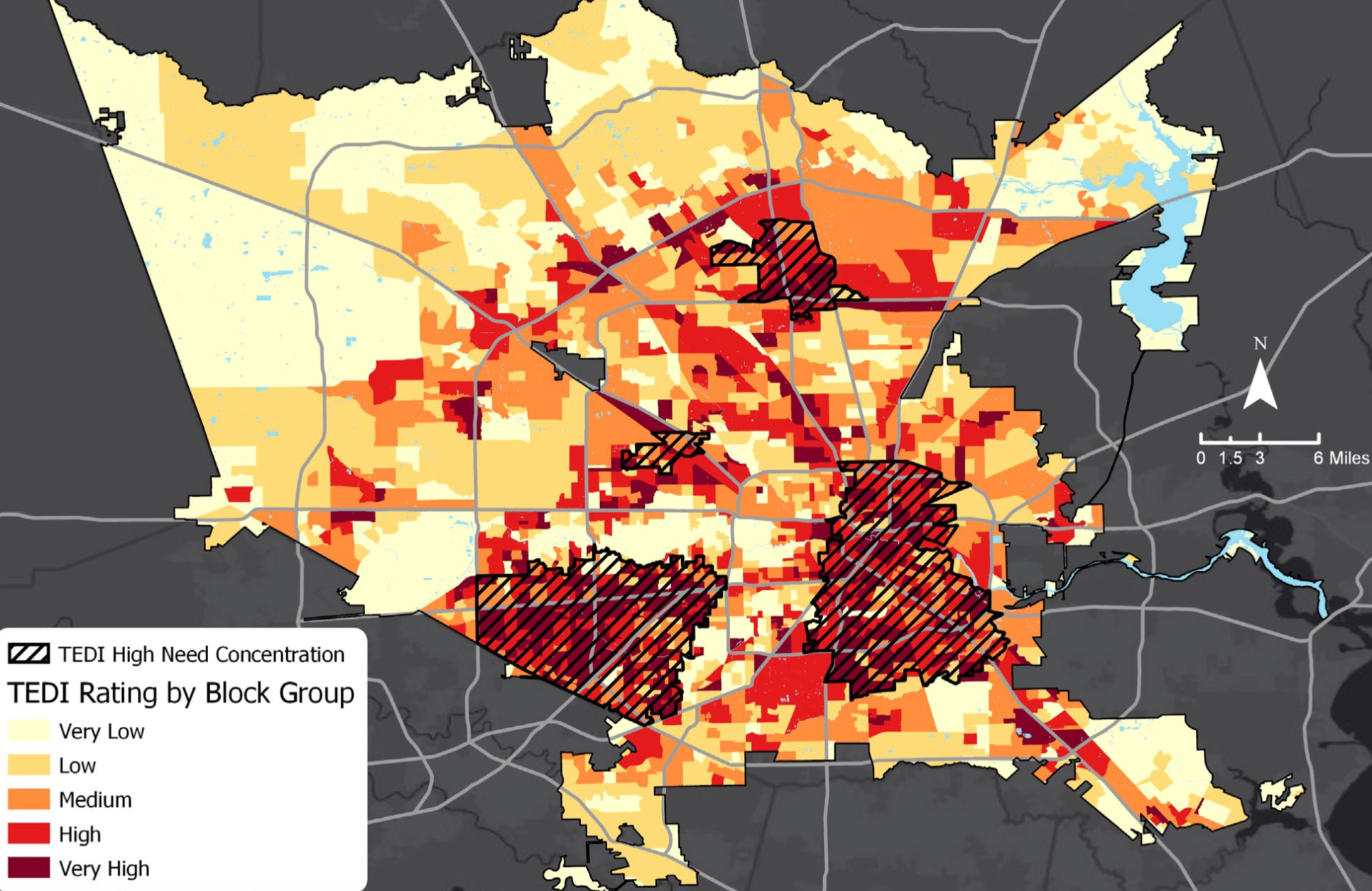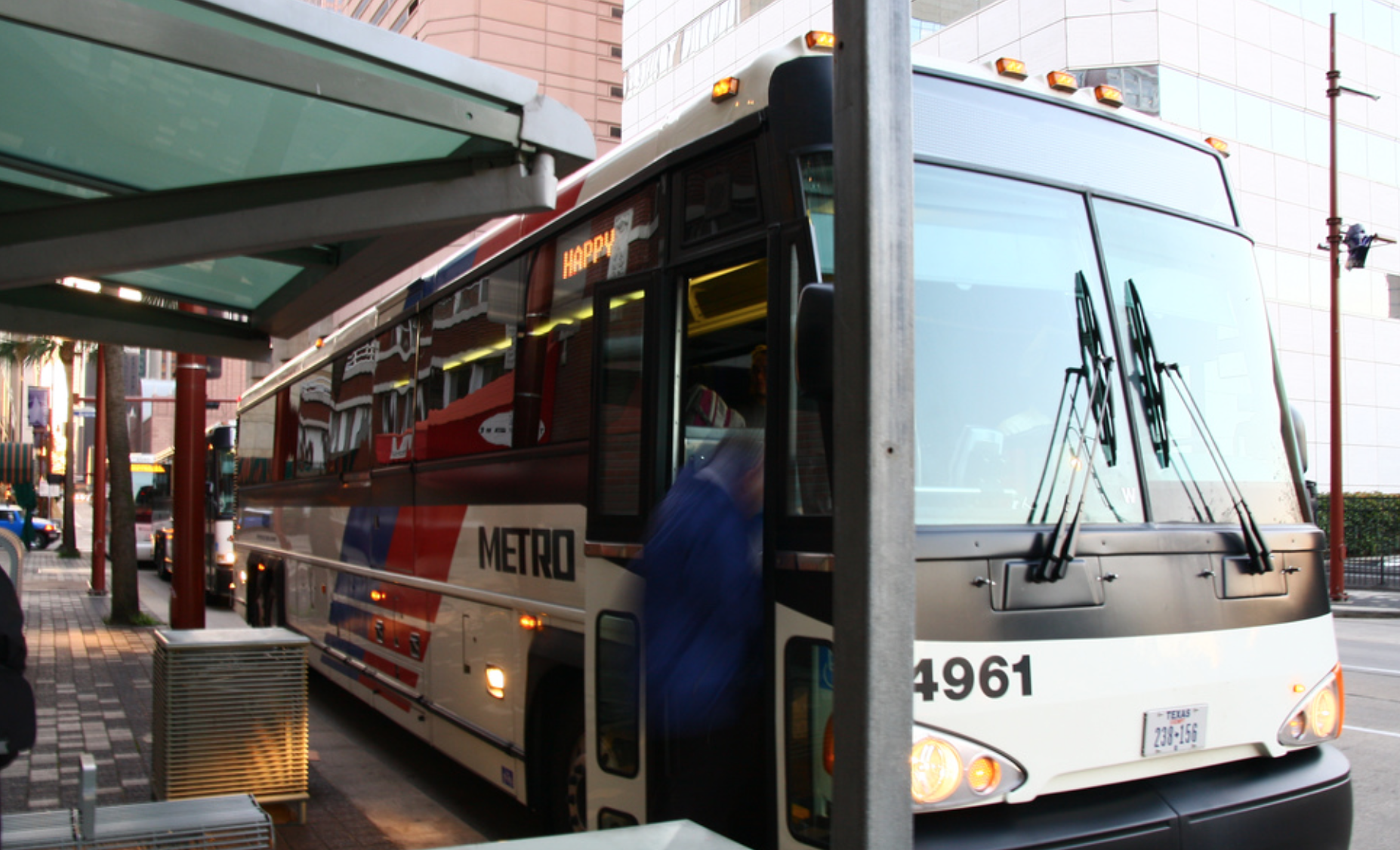Despite a reputation for ever-widening freeways and an abiding love affair with the automobile, many of Houston's neighborhoods have significant portions of their populations that do not have access to a car. Even for those who do, the burden of maintaining that car can be costly. According to a new report released Tuesday from transit advocacy group LINK Houston, whose board includes Kinder Institute Director Bill Fulton, an estimated 984,000 Houston area residents need more affordable transportation options. To address this need, the report argues, the region needs to invest in and create more frequent, reliable, accessible and available transit.
Houston is currently at a bit of a transit crossroads. While other cities struggle with ridership, Houston has actually seen gains in recent years, thanks in part to a 2015 bus route redesign and the introduction of additional light rail. Meanwhile, the mayor has declared the need for a paradigm shift in transportation planning in the area, adding his support to the approval of the city's first bike plan and calling for recommendations around several dangerous intersections. With the Metropolitan Transit Authority of Harris County's long-range plan in the works, LINK Houston's Equity in Transit report comes at what could be a pivotal time for the city.
Just as the bus route redesign managed to transform the transit network by focusing on local buses, the report argues that some of the most critical and important changes should occur at that local bus level. "While cities across the country chase after new technologies, behemoth infrastructure and new ridership in suburban areas," the report notes, "the reality in Houston is that the highest current ridership – and latent ridership – is on the local bus network."
The report looks at both the current system's reach and how well it connects residents to jobs, education, medical care and more, focusing on Metro's fixed route transit in the region's core. "That’s what transit is about: an affordable transportation option to connect people like you and me to opportunities. Those aren’t just places where we work, but also where we take classes, seek medical attention, shop for groceries, enjoy entertainment and do everything else in our daily lives," said Oni Blair, executive director, at the report's release Tuesday.
Using factors like intersection density, poverty, the share of households without any vehicles and other metrics, the report finds several high-demand areas including parts of west and southwest Houston and much of the east side of Harris County as well as pockets of need in places like Spring Branch and Greater Greenspoint. Current Metro coverage in these areas is good, according to the report, but could be better with improved frequency, availability, reliability and accessibility—challenges that fall largely but not entirely to Metro. Responsibility, the report notes, is shared by "current and future riders, government at every level, metropolitan planning organizations, as well as municipal management districts, Tax Increment Reinvestment Zones, advocacy organizations, other stakeholders, and neighborhoods."

Transit Equity Demand Index need mapped out by block group. Source: LINK Houston.
The report found that roughly 46 percent of local transit rides, either bus or rail, occurred during peak hours and roughly 56 percent of all riders used transit to get to work, meaning that a significant portion of trips are taken outside of peak hours and that many riders are using transit to get to a broad range of destinations, including errands, school, restaurants and more. While frequent transit covers roughly 40-percent of the high-need areas identified using the report's Transportation Equity Demand Index during the week, the biggest gaps occurred after 6 p.m. when frequency significantly slowed. "Access to frequent transit options in the evening matters to TEDI high-need areas," the report argues, "as these areas represent higher concentrations of hourly workers, who may be working jobs outside of the daytime hours, as well as areas where there are higher concentrations of all-purpose riders, using transit for a variety of reasons in addition to work trips."
With that in mind, the report's recommendations center on increasing the frequency of service, extending the hours of service, improving reliability and enhancing accessibility.
The report suggests doing away with the 60-minute waits on many routes, ensuring that buses come at least every 30 minutes on every route. In addition, the report identifies eight routes that it recommends moving to 15-minute service all day: 25, 40, 41, 51, 52, 54, 80, and 85. The report also suggests increasing the late-night frequency of light-rail lines across the city, among other network changes.
To extend the hours of service, the report identifies 12 priority routes that it argues should offer near 24-hour service: 2, 6, 9, 11, 14, 26, 33, 36, 40, 50, 73, and 102.
Improving on-time arrivals is also critical. According to Metro's own report on October ridership, just 75 percent of local bus trips were on time. That number should be at least 90 percent, according to the report. For some particularly high-frequency routes, like 82, that could mean eliminating route schedules entirely, reducing "complexity for riders and operators." In other instances, it means making schedules and real-time updates more available and transparent.
While many of the changes focused on Metro, increasing the system's overall accessibility requires collaborative efforts to build more and better sidewalks, crosswalks, curb cuts and other necessary infrastructure. The report also recommends building shelters specifically at stops with higher off-peak wait times.
While many of the changes are meant to increase service and access for high-need areas and communities, in particular, the report notes that the improvements would reach most riders and represent significant improvements for all users.
With less than 1 percent of the state's department of transportation funding allocated for public transit, the report notes that though all levels of government have a role to play, the state will have to step up. "Over the longer term, for public transit to keep up with our population growth, the region will need more federal and state funding; dollars allocated for and spent on public transit should constitute a larger total amount and a greater proportion of the state’s annual transportation budget in comparison with other modes," the report concludes.

